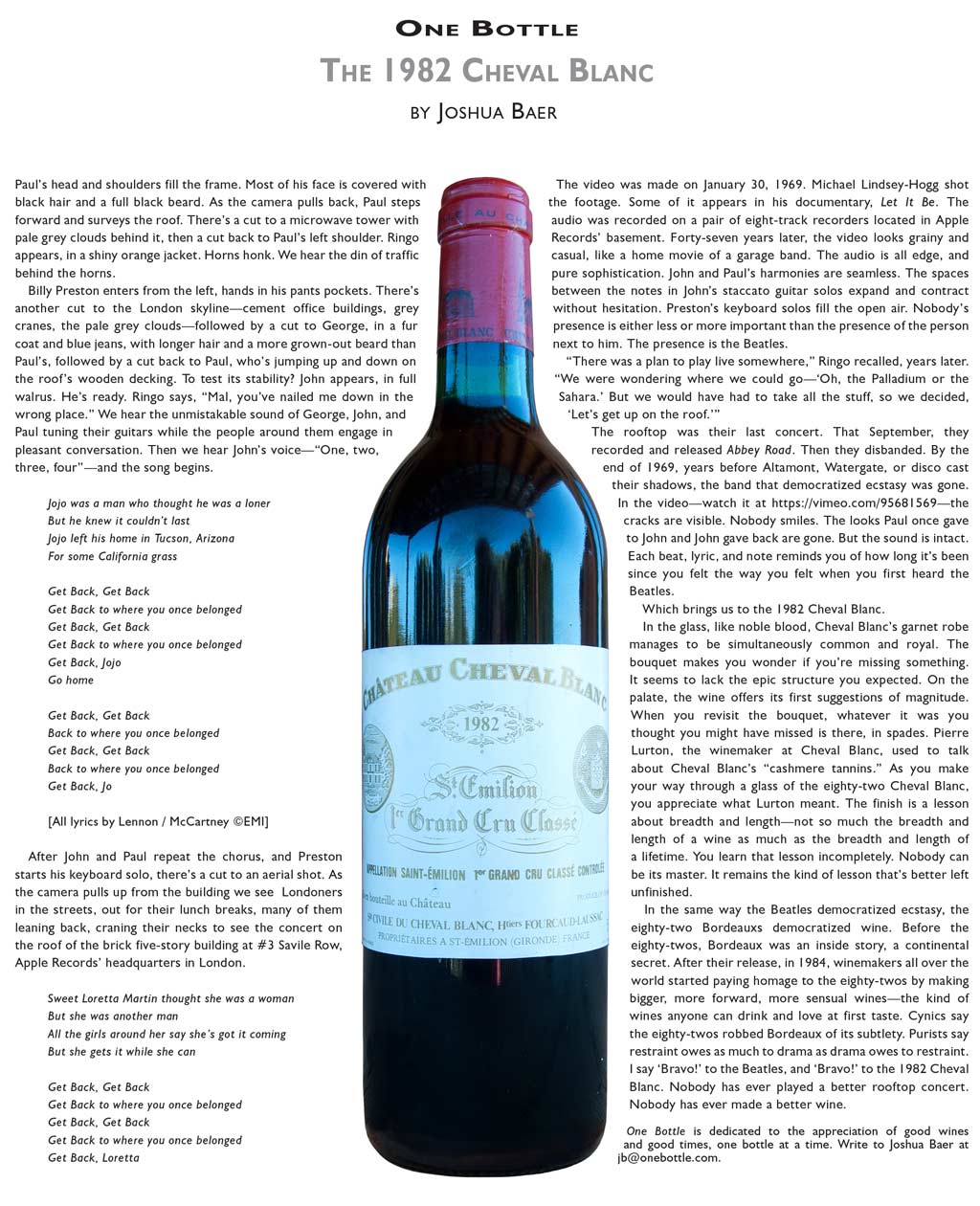1982 Cheval Blanc
Paul’s head and shoulders fill the frame. Most of his face is covered with black hair and a full black beard. As the camera pulls back, Paul steps forward and surveys the roof. There’s a cut to a microwave tower with pale grey clouds behind it, then a cut back to Paul’s left shoulder. Ringo appears, in a shiny orange jacket. Horns honk. We hear the din of traffic behind the horns.
Billy Preston enters from the left, hands in his pants pockets. There’s another cut to the London skyline—cement office buildings, grey cranes, the pale grey clouds—followed by a cut to George, in a fur coat and blue jeans, with longer hair and a more grown-out beard than Paul’s, followed by a cut back to Paul, who’s jumping up and down on the roof’s wooden decking. To test its stability? John appears, in full walrus. He’s ready. Ringo says, “Mal, you’ve nailed me down in the wrong place.” We hear the unmistakable sound of George, John, and Paul tuning their guitars while the people around them engage in pleasant conversation. Then we hear John’s voice—“One, two, three, four”—and the song begins.
Jojo was a man who thought he was a loner
But he knew it couldn’t last
Jojo left his home in Tucson, Arizona
For some California grass
Get Back, Get Back
Get Back to where you once belonged
Get Back, Get Back
Get Back to where you once belonged
Get Back, Jojo
Go home
Get Back, Get Back
Back to where you once belonged
Get Back, Get Back
Back to where you once belonged
Get Back, Jo
[All lyrics by Lennon / McCartney ©EMI]
After John and Paul repeat the chorus, and Preston starts his keyboard solo, there’s a cut to an aerial shot. As the camera pulls up from the building we see Londoners in the streets, out for their lunch breaks, many of them leaning back, craning their necks to see the concert on the roof of the brick five-story building at #3 Savile Row, Apple Records’ headquarters in London.
Sweet Loretta Martin thought she was a woman
But she was another man
All the girls around her say she’s got it coming
But she gets it while she can
Get Back, Get Back
Get Back to where you once belonged
Get Back, Get Back
Get Back to where you once belonged
Get Back, Loretta
The video was made on January 30, 1969. Michael Lindsey-Hogg shot the footage. Some of it appears in his documentary, Let It Be. The audio was recorded on a pair of eight-track recorders located in Apple Records’ basement. Forty-seven years later, the video looks grainy and casual, like a home movie of a garage band. The audio is all edge, and pure sophistication. John and Paul’s harmonies are seamless. The spaces between the notes in John’s staccato guitar solos expand and contract without hesitation. Preston’s keyboard solos fill the open air. Nobody’s presence is either less or more important than the presence of the person next to him. The presence is the Beatles.
“There was a plan to play live somewhere,” Ringo recalled, years later. “We were wondering where we could go—‘Oh, the Palladium or the Sahara.’ But we would have had to take all the stuff, so we decided, ‘Let’s get up on the roof.’”
The rooftop was their last concert. That September, they recorded and released Abbey Road. Then they disbanded. By the end of 1969, years before Altamont, Watergate, or disco cast their shadows, the band that democratized ecstasy was gone. In the video—watch it at https://vimeo.com/95681569—the cracks are visible. Nobody smiles. The looks Paul once gave to John and John gave back are gone. But the sound is intact. Each beat, lyric, and note reminds you of how long it’s been since you felt the way you felt when you first heard the Beatles.
Which brings us to the 1982 Cheval Blanc.
In the glass, like noble blood, Cheval Blanc’s garnet robe manages to be simultaneously common and royal. The bouquet makes you wonder if you’re missing something. It seems to lack the epic structure you expected. On the palate, the wine offers its first suggestions of magnitude. When you revisit the bouquet, whatever it was you thought you might have missed is there, in spades. Pierre Lurton, the winemaker at Cheval Blanc, used to talk about Cheval Blanc’s “cashmere tannins.” As you make your way through a glass of the eighty-two Cheval Blanc, you appreciate what Lurton meant. The finish is a lesson about breadth and length—not so much the breadth and length of a wine as much as the breadth and length of a lifetime. You learn that lesson incompletely. Nobody can be its master. It remains the kind of lesson that’s better left unfinished.
In the same way the Beatles democratized ecstasy, the eighty-two Bordeauxs democratized wine. Before the eighty-twos, Bordeaux was an inside story, a continental secret. After their release, in 1984, winemakers all over the world started paying homage to the eighty-twos by making bigger, more forward, more sensual wines—the kind of wines anyone can drink and love at first taste. Cynics say the eighty-twos robbed Bordeaux of its subtlety. Purists say restraint owes as much to drama as drama owes to restraint. I say ‘Bravo!’ to the Beatles, and ‘Bravo!’ to the 1982 Cheval Blanc. Nobody has ever played a better rooftop concert. Nobody has ever made a better wine.
One Bottle is dedicated to the appreciation of good wines and good times, one bottle at a time. You can write to Joshua Baer at jb@onebottle.com.
